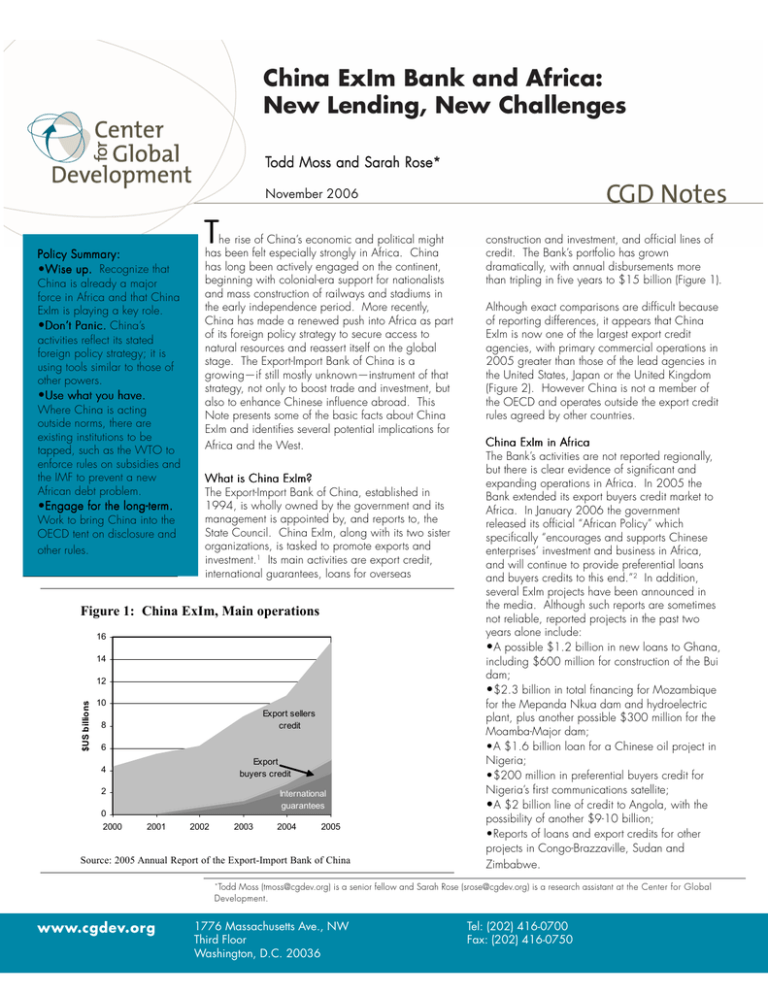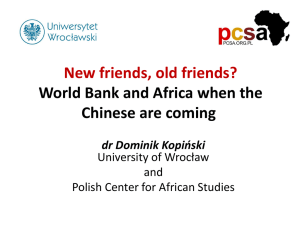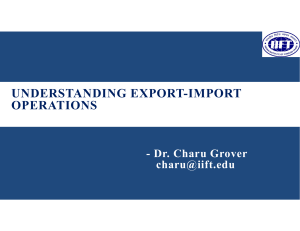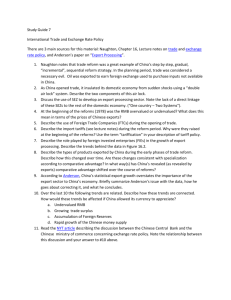China ExIm Bank and Africa: New Lending, New Challenges
advertisement

China ExIm Bank and Africa: New Lending, New Challenges Todd Moss and Sarah Rose * Rose* November 2006 Policy Summar y: Summary: •Wise up. Recognize that China is already a major force in Africa and that China ExIm is playing a key role. Don’tt Panic. China’s •Don’ activities reflect its stated foreign policy strategy; it is using tools similar to those of other powers. •Use what you have. Where China is acting outside norms, there are existing institutions to be tapped, such as the WTO to enforce rules on subsidies and the IMF to prevent a new African debt problem. m. •Engage for the long-ter long-term. Work to bring China into the OECD tent on disclosure and other rules. T he rise of China’s economic and political might has been felt especially strongly in Africa. China has long been actively engaged on the continent, beginning with colonial-era support for nationalists and mass construction of railways and stadiums in the early independence period. More recently, China has made a renewed push into Africa as part of its foreign policy strategy to secure access to natural resources and reassert itself on the global stage. The Export-Import Bank of China is a growing—if still mostly unknown—instrument of that strategy, not only to boost trade and investment, but also to enhance Chinese influence abroad. This Note presents some of the basic facts about China ExIm and identifies several potential implications for Africa and the West. What is China ExIm? The Export-Import Bank of China, established in 1994, is wholly owned by the government and its management is appointed by, and reports to, the State Council. China ExIm, along with its two sister organizations, is tasked to promote exports and investment.1 Its main activities are export credit, international guarantees, loans for overseas Figure 1: China ExIm, Main operations 16 14 $US billions 12 10 Export sellers credit 8 6 Export buyers credit 4 2 0 2000 International guarantees 2001 2002 2003 2004 2005 Source: 2005 Annual Report of the Export-Import Bank of China construction and investment, and official lines of credit. The Bank’s portfolio has grown dramatically, with annual disbursements more than tripling in five years to $15 billion (Figure 1). Although exact comparisons are difficult because of reporting differences, it appears that China ExIm is now one of the largest export credit agencies, with primary commercial operations in 2005 greater than those of the lead agencies in the United States, Japan or the United Kingdom (Figure 2). However China is not a member of the OECD and operates outside the export credit rules agreed by other countries. China ExIm in Africa The Bank’s activities are not reported regionally, but there is clear evidence of significant and expanding operations in Africa. In 2005 the Bank extended its export buyers credit market to Africa. In January 2006 the government released its official “African Policy” which specifically “encourages and supports Chinese enterprises’ investment and business in Africa, and will continue to provide preferential loans and buyers credits to this end.”2 In addition, several ExIm projects have been announced in the media. Although such reports are sometimes not reliable, reported projects in the past two years alone include: •A possible $1.2 billion in new loans to Ghana, including $600 million for construction of the Bui dam; •$2.3 billion in total financing for Mozambique for the Mepanda Nkua dam and hydroelectric plant, plus another possible $300 million for the Moamba-Major dam; •A $1.6 billion loan for a Chinese oil project in Nigeria; •$200 million in preferential buyers credit for Nigeria’s first communications satellite; •A $2 billion line of credit to Angola, with the possibility of another $9-10 billion; •Reports of loans and export credits for other projects in Congo-Brazzaville, Sudan and Zimbabwe. * Todd Moss (tmoss@cgdev.org) is a senior fellow and Sarah Rose (srose@cgdev.org) is a research assistant at the Center for Global Development. www.cgdev.org 1776 Massachusetts Ave., NW Third Floor Washington, D.C. 20036 Tel: (202) 416-0700 Fax: (202) 416-0750 By comparison, US ExIm supported transactions in all of sub-Saharan Africa totaled less than $500 million in 2005. Implications for Africa The growth of Chinese export credit in Africa provides African governments with alternative sources of finance and helps to diversify trading partners for countries that have tended to remain stuck in old colonial patterns. China ExIm, like other Chinese lending, does not come with the political, environmental, or human rights conditions often attached to Western agency funds. (Adherence to a “one China” policy is perhaps the most prominent exception.) For pariah regimes like Sudan or Zimbabwe, these credits can be a lifeline. For countries such as Ghana or Mozambique which are heavily dependent on foreign aid, Chinese loans can offer another source of capital and potentially be used as leverage against donor demands. China ExIm is also targeting sectors where Western private or official capital is often scarce. Chinese companies and banks are investing heavily in physical infrastructure, a sector with high demand that most donors have neglected in Africa in favor of education and health. Chinese firms, with official financial banking from banks like ExIm, have also entered markets generally shunned by the Western private sector because of risk, lack of information, or concerns about corruption. On the negative side, Chinese firms often import their own labor which limits the economic spillover effects. The flip-side of having lower labor or environmental standards is that even weak local laws to protect the public can be subverted. In addition, recent events in Zambia have suggested that Chinese investment is not immune to the nationalist backlashes occasionally directed at foreigners. Figure 2: Major Export Credit Agencies, selected activities 18 16 14 International Guarantees Export Credit Insurance 12 $US billions Export Buyers Credit 10 Guarantees 8 Export Sellers Credit 6 Total Guarantees Overseas Investment Insurance Loans 4 Supplier Credit Insurance 2 Buyer & Supplier Credit 0 China Exim US Exim JBIC ECGD Sources: 2005 Annual Report of the Export-Import Bank of China, 2005 Annual Report of the ExportImport Bank of the United States, Japan Bank for International Cooperation Annual Report 2005, and 2005-06 Annual Review and Resource Account of the Export Credits Guarantee Department (UK). Note: Data for China is for 2005 disbursements, U.S. for 2005 authorizations, Japan for FY2004 commitments, and UK for FY05/06 issuances. Figures do not include official development assistance. www.cgdev.org 1776 Massachusetts Ave., NW Third Floor Washington, D.C. 20036 Tel: (202) 416-0700 Fax: (202) 416-0750 Challenges for W ester n Policymakers Wester estern To the extent that Chinese export credit promotes economic growth in Africa, recent trends should be welcomed by policymakers in Western capitals. At the same time, the mounting activities of China, and China ExIm in particular, presents some complications. Competitiveness. The use of ExIm and the other official agencies to effectively subsidize China’s firms undoubtedly impacts competitors. Where official export credit is available for Western firms, it often comes with substantial reporting requirements and other strings. Because many of the Chinese firms are state-owned, they may also not be under the same shareholder pressure for profitability as long as they are serving some foreign policy goal. Leverage. To the extent that creditors have in the past been a cartel, giving them bargaining power to extract concessions from clients, they may now lose that leverage on borrowing governments. China, for instance, provided a potential alternative source of capital for Chad, which weakened the position of the World Bank in its recent renegotiations over the use of funds from the ChadCameroon pipeline project. Transparency and governance. China ExIm does not report its own activities in the same way as the other similar agencies (for example, the terms of its loans in Africa are rarely made public) and the Bank does not place reporting demands on its clients. This not only undermines export credit rules aimed at keeping a level playing field, but could also hurt global efforts to reduce the secrecy around the financing and contracting of large infrastructure or oil projects, such as the Extractive Industry Transparency Initiative (EITI). Angola, for example, has able to resist IMF demands for increased budget transparency partly because China ExIm has been willing to lend.3 Environmental and social standards. Since 2004 China ExIm has required its borrowers to submit to internal review and comply with local laws of the host country, but the standards and procedures are ambiguous. China is not party to OECD efforts to require environmental impact assessment on projects supported by export credit, nor have Chinese banks signed up to the Equator Principles which sets voluntary environmental and social standards for banks on all project lending greater than $10 www.cgdev.org 1776 Massachusetts Ave., NW Third Floor Washington, D.C. 20036 million. Proposals to enhance the development impact of export credit also depend on how China ExIm responds.4 Debt sustainability. Perhaps most contentiously, much Chinese lending has been on the back of debt relief. Several of China ExIm’s borrowers (Ghana, Mozambique, Congo-Brazzaville) have recently received major debt reductions through the heavily indebted poor countries (HIPC) initiative. New lending, which is often nonconcessional, could be an economic problem if low-income countries accumulate too much debt too quickly and find themselves back in an unsustainable situation. Politically, the costs are even higher. The recent G8 debt relief initiative granted up to 100% debt relief for HIPCs partly on the basis that these countries were too poor to bear any debt. If those same countries immediately borrow again, creditors (and legislatures and taxpayers) who are still appropriating funds to pay for debt relief may (rightly) view such efforts as indirectly subsidizing new Chinese lending. Conclusion The rise of China ExIm is a potentially important trend for African development by providing a new source of capital, especially for much-needed infrastructure investment. The growing operations of Chinese official banks also present a number of challenges to policymakers to mitigate the impact of Chinese lending practices on efforts to promote better governance, standards, and debt sustainability. An essential first step will be gathering better information about ExIm’s activities and engaging with China—bilaterally and through the OECD, WTO and IMF—on the full range of contentious issues. Endnotes 1 The Agricultural Development Bank of China and the China Development Bank. 2 Government of China, “China’s African Policy,” January 2006. 3 Louisa Lombard, “Africa’s China Card. Foreign Policy,” Foreign Policy, web exclusive, April 2006. 4 James Harmon, et al. “Diverging Paths: What Future for Export Credit Agencies in Development Finance?” World Resources Institute, 2005. Tel: (202) 416-0700 Fax: (202) 416-0750





